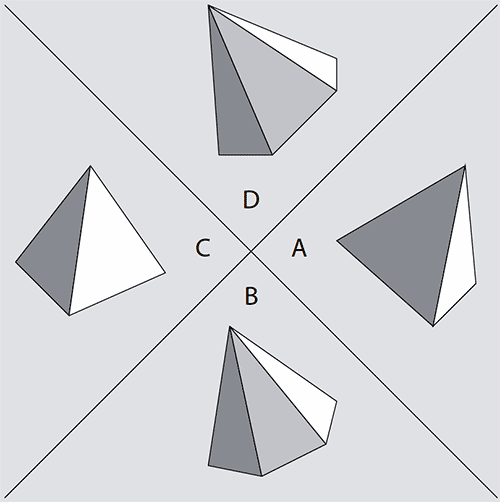Article
Dreneva A.A. (2020). Categorical search for three-dimensional shapes in participants with different level of mathematical expertise. National Psychological Journal, [Natsional’nyy psikhologicheskiy zhurnal], (13)1, 57–65.
Abstract
Background. The paper considers the issue of categorical search for three-dimensional geometric shapes. The results of the previous studies on the real-world objects showed that pre-attentive extrafoveal analysis provides an effective identification of the target, reflecting in the right direction of the first saccade compared with the random search.
Objective. In this study, we investigated the efficacy of extrafoveal analysis during categorical search for pyramids in two groups of participants: mathematicians and psychologists.
Design. 15 mathematicians and 17 psychologists aged 18-25 participated in the study. Each participant performed 144 trialssearching for the target pyramid among the distractor pyramids. In the series 2and 9, any eye movements were prohibited to study covert attention.
Results. The findings of the experiment failed to reveal any differences in the use of extrafoveal analysis and accuracy in both groups. We observed dramatic individual differences, revealed in various degrees of extrafoveal analysis in the search process and in changing the strategy of the task solving. Special series which prohibited eye movements, demonstrated a significant role of covert attention in the categorical search, as well as the possibility and effectiveness of extrafoveal analysis even though while free instruction it could not be used by all participants and all cases.
Conclusion. During categorical search both foveal and extrafoveal processing of stimuli, as well as pre-attentive analysis and covert attention, were simultaneously involved. The dynamics of their interaction was determined by low-level perceptual processes, individual characteristics of the subjects, the task specificity and the instruction.
Accepted: 02/15/2020
Pages: 57-65
DOI: 10.11621/npj.2020.0106
PDF: Download
Keywords: categorical search; extrafoveal analysis; covert attention; pre-attentive processing; three-dimensional shapes; perceptual processes; механизмы зрительного поиска; attention; interindividual differences;
Available Online 31.03.2020
Tab. 1. Number of correct answers in groups of mathematicians and psychologists
|
Mathematicians ("experts") |
Psychologists ("freshers") |
||
|
Subject's initials |
Number of correct answers (%) |
Subject's initials |
Number of correct answers (%) |
|
V |
58,9 |
T |
50 |
|
A1 |
65,3 |
A4 |
50,7 |
|
M1 |
68,5 |
A5 |
54,9 |
|
A2 |
68,7 |
M3 |
55,2 |
|
A3 |
69,2 |
I |
56,6 |
|
Y |
69,9 |
M4 |
62,5 |
|
N |
70,6 |
D2 |
69,7 |
|
E1 |
72,1 |
V |
74,8 |
|
E2 |
72,9 |
E3 |
76,1 |
|
D1 |
74,1 |
M5 |
77,8 |
|
S |
90,2 |
K2 |
78 |
|
K1 |
91 |
A6 |
81,1 |
|
M2 |
93,1 |
A7 |
82,6 |
|
K3 |
82,6 |
||
|
A8 |
84 |
||
|
D3 |
85 |
||
|
Average |
74,2 |
Average |
70,1 |
|
Median |
70,6 |
Median |
75,45 |

Fig. 1. Sample stimulus slide

Fig. 2. Histogram of average FirstT indicators in subjects

Fig. 3. Relationship between the dynamics of the indicator FirstT and the average FirstT in subjects
Acknowledgments
The work was carried out as part of a research project under the RFBR grant “Extrafoveal analysis of visual stimuli given by mathematical concepts: the interaction of descending and ascending processes”. Contract N 18-013-00869
For citing this article:
Dreneva A.A. (2020). Categorical search for three-dimensional shapes in participants with different level of mathematical expertise. National Psychological Journal, [Natsional’nyy psikhologicheskiy zhurnal], (13)1, 57–65.


